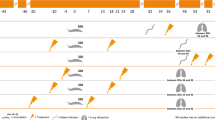Abstract
The objective of the present study was to evaluate the efficacy and safety of the antiparasitic spot-on formulation containing imidacloprid 10%/moxidectin 1% (Advocate®, Bayer) in the treatment of natural feline infection with the lungworm Aelurostrongylus abstrusus (Nematoda, Strongylida). The efficacy of Advocate® administered once was tested in comparison to a control oral formulation containing fenbendazole 18.75% (Panacur® Intervet) administered over three consecutive days based on larvae per gramme of faeces (LPG), measured on days 28 ± 2 following treatment and compared to counts on days −6 to −2. In total 24 cats treated either with Advocate® (n = 12) or with Panacur® (n = 12) were included. Mean LPG postbaseline (days 28 ± 2) were low in both treatment groups, i.e., 0 LPG for Advocate® and 1.3 LPG for Panacur®. Reduction of post-baseline larval counts showed Advocate® (100% reduction) to be superior in efficacy compared to the control product (99.29% reduction). No treated animals showed adverse events. This trial demonstrated that both Advocate® spot-on formulation and Panacur® oral paste are safe and effective in the treatment of aelurostrongylosis in cats. Future practical perspectives in feline medicine and the major advantages of the spot-on product compared to the oral paste are discussed.
Similar content being viewed by others
References
Anderson RC (2000) The Superfamily Metastrongyloidea. In: Nematode Parasites of Vertebrates. Their Development and Trasmission, 2nd edn., CABI Publishing, Guilford, UK.
Barrs VR, Swinney GR, Martin P, Nicoll RG (1999) Concurrent Aelurostrongylus abstrusus infection and salmonellosis in a kitten. Aust Vet J 77:229–232.
Blagburn BL, Hendrix CM, Lindsay DS, Vaughan JL (1987) Anthelmintic efficacy of ivermectin in naturally parasitized cats. Am J Vet Res 48:670–672.
Bowman DD, Hendrix CM, Lindsay DS, Barr SC (2002) Feline clinical parasitology. Iowa State University, Blackwell Science Company, USA.
Clayton HM (1983) The management and treatment of respiratory nematode infections in small animals. Vet Ann 23:254–259.
Euzeby J (1981) La coprologie chez les carnivores. In: Diagnostic expérimental des helminthoses animales. Travaux pratiques d’helminthologie vétérinaire, Livre 1, Informations Techniques des Services Vétérinaires, Paris, France.
Grandi G, Calvi LE, Venco L, Paratici C, Genchi C, Memmi D, Kramer LH (2005) Aelurostrongylus abstrusus (cat lungworm) infection in five cats from Italy. Vet Parasitol 134:177–182.
Hamilton JM (1963) Aelurostrongylus abstrusus infestation of the cat. Vet Rec 75:417–422.
Hamilton JM, Weatherley A, Chapman AJ (1984) Treatment of lungworm disease in the cat with fenbendazole. Vet Rec 114:40–41.
Kirkpatrick CE, Megella C (1987) Use of ivermectin in treatment of Aelurostrongylus abstrusus and Toxocara cati infection in a cat. J Am Vet Med Assoc 190:1309–1310.
Lewis DT, Merchant SR, Neer TM (1994) Ivermectin toxicosis in a kitten. J Am Vet Med Assoc 205:584.
Miller BH, Roudebush P, Nard HG (1984) Pleural effusion as a sequel to aelurostrongylosis in a cat. J Am Vet Med Assoc 185:556–557.
Naylor JR, Hamilton JM, Weatherley AJ (1984) Changes in the ultrastructure of feline pulmonary arteries following infection with the lungworm Aelurostrongylus abstrusus. Br Vet J 140:181–190.
Pechman RD (1995) Respiratory parasites. In: Sherding RD (ed) The cat: diseases and clinical management. Churchill Livingstone, New York, USA.
Ribeiro VM, Lima WS (2001) Larval production of cats infested and re-infested with Aelurostrongylus abstrusus (Nematoda: Protostrongylidae). Rév Méd Vét 152:815–820.
Roberson EL, Burke TM (1980) Evaluation of granulated fenbendazole (22.2%) against induced and naturally occurring helminth infections in cats. Am J Vet Res 41:1499–1502.
Schmid K, Duwel D (1990) Use of fenbendazole (Panacur® tablets ad. us. vet.) against helminth infections in cats. Tieraerzt Umsch 45:873–875.
Scott DW (1972) Current knowledge of Aelurostrongylus abstrusus in the cat. Cornell Vet 63:483–500.
Sloss MW, Kemp RL, Zajac AM (1994) Fecal examination: dogs and cats. In: Veterinary Clinical Parasitology, 6th edn., Iowa State University Press, Ames, USA.
Stockdale PH (1970) The pathogenesis of the lesions elicited by Aelurostrongylus abstrusus during its prepatent period. Vet Pathol 7:102–115.
Traversa D, Guglielmini C (2008) Feline aelurostrongylosis and canine angiostrongylosis: a challenging diagnosis for two emerging verminous pneumonia infections. Vet Parasitol 157:163–174.
Traversa D, Lia RP, Iorio R, Boari A, Paradies P, Capelli G, Avolio S, Otranto D (2008b) Diagnosis and risk factors of Aelurostrongylus abstrusus (Nematoda, Strongylida) infection in cats from Italy. Vet Parasitol 153:182–186.
Traversa D, Di Cesare A, Milillo P, Iorio R, Otranto D (2008c) Aelurostrongylus abstrusus in a feline colony from central Italy: clinical features, diagnostic procedures and molecular characterization. Parasitol Res 103:1191–1196.
Traversa D, Iorio R, Otranto D (2008a) Diagnostic and clinical implications of a nested PCR specific for the ribosomal DNA of feline lungworm Aelurostrongylus abstrusus (Nematoda, Strongylida). J Clin Microbiol 46:1811–1817.
VICH guideline 9: Good clinical practice. Veterinary International Cooperation on Harmonization, European Agency for the Evaluation of Medicinal Products, London, July 2000.
VICH guideline 19: Efficacy of anthelmintics: specific recommendations for canine. Veterinary International Cooperation on Harmonization, European Agency for the Evaluation of Medicinal Products, London, July 2001.
Author information
Authors and Affiliations
Corresponding author
Rights and permissions
About this article
Cite this article
Traversa, D., Di Cesare, A., Milillo, P. et al. Efficacy and Safety of Imidacloprid 10%/Moxidectin 1% Spot-on Formulation in the Treatment of Feline Aelurostrongylosis. Parasitol Res 105 (Suppl 1), 55–62 (2009). https://doi.org/10.1007/s00436-009-1496-8
Published:
Issue Date:
DOI: https://doi.org/10.1007/s00436-009-1496-8




